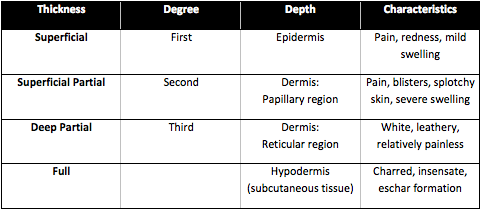Burns, Superficial (First-Degree)
A burn is an injury to the tissue of the body, typically the skin. Burns can vary in severity from mild to life-threatening. Most burns only affect the uppermost layers of skin, but depending on the depth of the burn, underlying tissues can also be affected. Traditionally, burns are characterized by degree, with first being least severe and third being most. However, a more precise classification system referring to the thickness or depth of the wound is now more commonly used. For the sake of this article, burns will be described by thickness. For a comparison of the two classification systems, see the table below.

Superficial, or first-degree burns only affect the epidermis (the outermost layer of skin), and typically the epidermis remains intact. This is important in that the epidermis helps regulate temperature and protects the body from infection.
Another contributing factor to burn severity is how much of the body is affected. The "rule of nines" is a method of approximation used to determine what percentage of the body is burned. Partial- or full-thickness burns on more than 15% of the body require immediate professional medical attention. The following approximations can be used for adults:
- Head (front and back) ~ 9%
- Front of the torso ~ 18%
- Back of the torso ~ 18%
- Each leg (front and back) ~ 18%
- Each arm (front and back) ~ 9%
- Genitals/Perineum ~ 1%
Additionally, the palm (not including the fingers or wrist area) is approximately 1% of the total surface area of the body, and can be used to approximate noncontiguous burn areas.
Symptoms of Superficial (First-Degree) Burns
With superficial burns, the skin will typically be red (erythema), swollen, dry, itchy, and sensitive to the touch. Blanching of the skin will occur when it is lightly pressed. These burns do not form blisters.
Etiology
Burns can be caused by a large variety of external factors. The most common types of burns are:
- Thermal: Caused by fire, hot objects, steam or hot liquids (scalding).
- Electrical: Caused by contact with electrical sources or, in much more rare circumstances, by lightning strike.
- Radiation: Caused by prolonged exposure to sources of UV radiation such as sunlight (sunburn), tanning booths, or sunlamps or by X-rays, radiation therapy or radioactive fallout.
- Chemical: Caused by contact with highly acidic or basic substances.
- Friction: Caused by friction between the skin and hard surfaces, such as roads, carpets or floors.
- Respiratory: Damage to the airways caused by inhaling smoke, steam, extremely hot air, or toxic fumes.
Complications
- Infection: One of the main functions of the skin is to act as a barrier against outside infection. However, this physical barrier is broken with partial- or full-thickness burn wounds. With severe burns, hard, avascular eschar forms, providing an environment prone to microbial growth. In addition, eschar makes it more difficult for antibodies and antibiotics to reach the wound site.
- Circumferential burns: In cases where a full thickness burn affects the entire circumference of a digit, extremity, or even the torso, this is called a circumferential burn. These are particularly problematic because when relatively pliable skin is replaced by dry, tough eschar it can affect circulation to the distal area and result in compartment syndrome. To reduce the risk from the resulting edema, an escharotomy will be performed, making a surgical incision through the thick eschar down to the subcutaneous tissue.
- Hypovolemic and Hypothermic Shock: Other key functions of the skin are to regulate fluid loss due to evaporation and regulate body heat. When large areas of the skin are burned, the risk of hypovolemia (decreased blood volume) rises substantially and can send the patient into shock. Additionally, hypothermia is part of the "trauma triad of death" which, along with lactic acidosis and coagulopathy, significantly increases mortality rates in patients with severe trauma.
- Wound progression: Swelling and decreased blood flow to the affected tissue at burn sites can result in partial-thickness burns developing into full-thickness burns.
- Tetanus: Burn sites are specifically susceptible to tetanus. If the patient hasn't been immunized in the past 5 years, generally a booster shot is recommended.
Treatments & Interventions for Superficial Burns
The three major goals for treating any burn are to prevent shock, relieve pain and discomfort, and reduce the risk of infection.
For superficial burns the first step is to run cool (not cold) water over the area for about 10 minutes then loosely cover the area with a sterile, non-adhesive bandage. Protect the affected area from pressure or friction during the healing process. Over-the-counter pain relievers can help reduce pain and inflammation.
The following precautions should be observed in dealing with any type of burn:
- Do not apply ice to the affected area. Doing so can cause further damage to the wound and increase the risk of hypothermia.
- Do not apply butter, ointment, petroleum jelly, oil, or grease on the burn. Not only do wounds need air to heal, but these also trap heat at the burn site and can further damage deeper tissues.
- Do not peel off dead skin, as this can result in further scarring and infection.
- Do not cough or breathe directly on the affected area.
References
Heller JL. Burns. MedlinePlus. http://www.nlm.nih.gov/medlineplus/ency/article/000030.htm. Updated September 5, 2017. Accessed September 13, 2017.
WebMD. Burns and Electric Shock - Topic Overview. WebMD. http://firstaid.webmd.com/tc/burns-topic-overview. Accessed September 13, 2017.
Wedro B. First Aid for Burns. MedicineNet.com. http://www.medicinenet.com/burns/article.htm#tocb. Accessed September 13, 2017.







